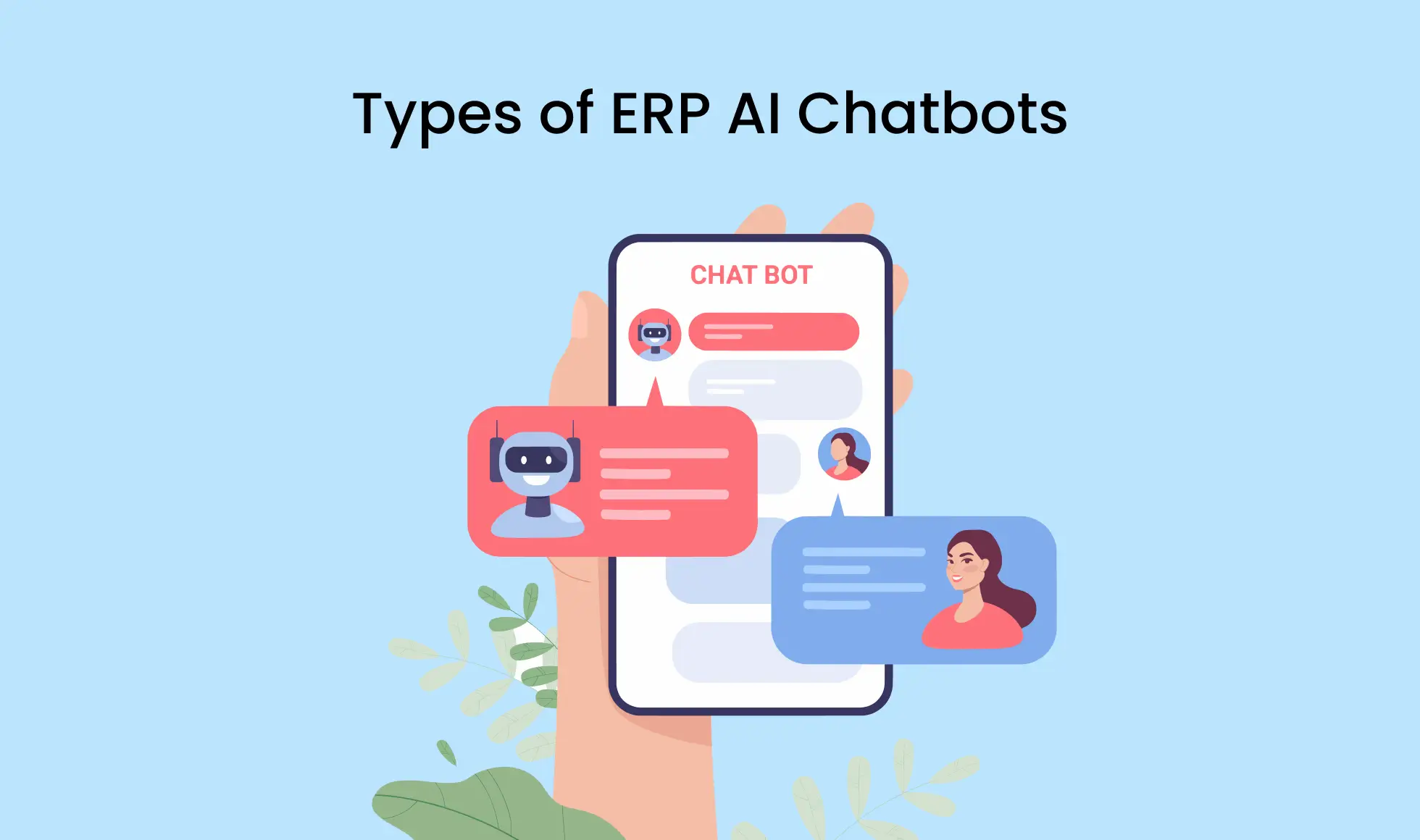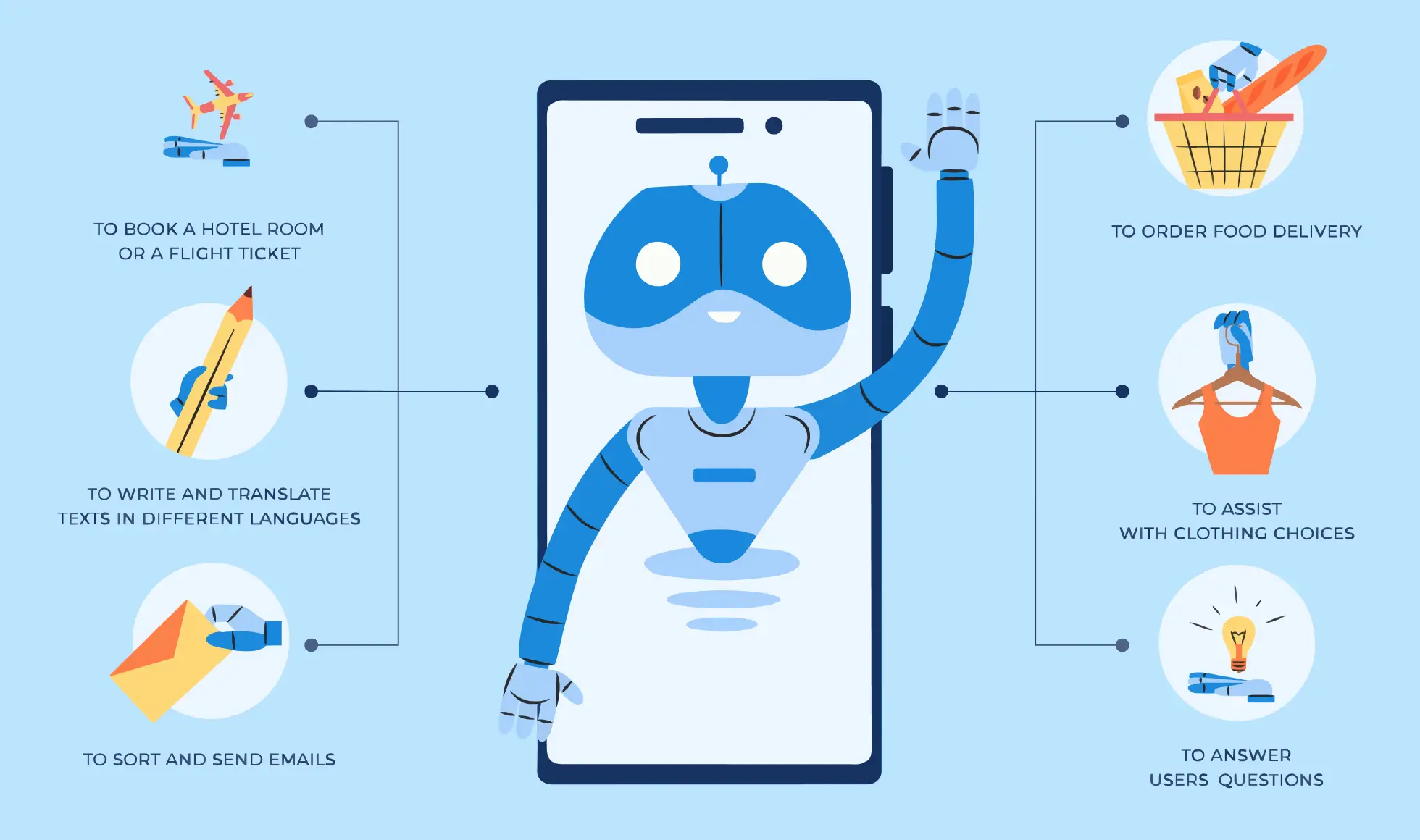Tired of navigating complex ERP systems? Imagine having a personal assistant at your fingertips, ready to answer your questions, provide insights, and even automate routine tasks. Welcome to the world of AI-powered ERP chatbots. These intelligent virtual assistants are revolutionizing the way organizations interact with their data, making it easier, faster, and more efficient than ever before.
Here you will get to know all about ERP AI chatbot, including how it works and how you can create it for your business.
Key Components of ERP AI Chatbot
An ERP AI chatbot is a sophisticated software application that combines the power of artificial intelligence (AI) with the capabilities of enterprise resource planning (ERP) systems. It leverages natural language processing (NLP) and machine learning (ML) to understand and respond to user queries related to ERP data and processes.
The key components of an ERP AI chatbot include:
Natural Language Processing (NLP)
NLP is the cornerstone of an ERP AI chatbot, enabling it to understand and interpret human language. It involves:
- Tokenization: Breaking down text into individual words or tokens.
- Part-of-speech tagging: Identifying the grammatical category of each word (e.g., noun, verb, adjective).
- Named entity recognition: Identifying named entities such as people, organizations, and locations.
- Sentiment analysis: Determining the emotional tone of the text (e.g., positive, negative, neutral).
Machine Learning (ML)
ML algorithms empower the chatbot to learn from interactions and improve its responses over time. This includes:
- Supervised learning: Training the chatbot on labeled data to recognize patterns and relationships.
- Unsupervised learning: Discovering hidden patterns and structures within the data.
- Reinforcement learning: Learning through trial and error, receiving rewards for correct actions and penalties for incorrect ones.
ERP Integration
To access and process relevant ERP data, the chatbot must be integrated with the organization's ERP system. This typically involves:
- API integration: Using APIs to connect the chatbot to the ERP system's data.
- Data extraction: Extracting necessary data from the ERP system.
- Data transformation: Converting data into a format that the chatbot can understand and process.
These three key components work together to create a powerful and effective ERP AI chatbot that can provide valuable assistance to users and improve organizational efficiency.
Types of ERP AI Chatbots that businesses use

ERP AI chatbots come in various forms, each with its own strengths and use cases:
Rule-based Chatbots
Rule-based chatbots are the most basic type, operating on a set of predefined rules and scripts. They are well-suited for simple, repetitive tasks that can be easily defined and automated.
Key characteristics:
- Predefined rules: Follow a fixed set of instructions.
- Limited adaptability: Unable to handle unexpected queries or situations.
- Suitable for simple tasks: Ideal for answering frequently asked questions or providing basic information.
Machine Learning-Based Chatbots
Machine learning-based chatbots leverage ML algorithms to learn from interactions and improve their responses over time. They are more adaptable and can handle a wider range of queries, making them better suited for complex scenarios.
Key characteristics:
- Continuous learning: Improve their performance through experience.
- Adaptability: Can handle a variety of queries and situations.
- Suitable for complex tasks: Ideal for tasks that require understanding context and nuance.
Hybrid Chatbots
Hybrid chatbots combine the strengths of rule-based and machine learning-based chatbots. They use predefined rules for simple tasks and machine learning for more complex queries, providing a balanced approach.
Key characteristics:
- Combination of approaches: Leverage both rule-based and ML techniques.
- Flexibility: Can handle a wide range of queries.
- Suitable for a variety of tasks: Ideal for organizations with varying levels of complexity.
The choice of chatbot type depends on the specific needs and requirements of the organization. For simple tasks, rule-based chatbots may be sufficient. However, for more complex scenarios, machine learning-based or hybrid chatbots are likely to be more effective.
How ERP AI Chatbots Help You Streamline Queries
ERP AI chatbots can offer significant benefits to organizations, including:
1. Improved Efficiency
ERP AI chatbots can significantly enhance efficiency by automating repetitive tasks, providing faster access to information, and reducing human errors.
2. Enhanced User Experience
These chatbots offer a personalized and convenient user experience by providing 24/7 support, tailored recommendations, and simplified interactions with ERP systems.
3. Better Decision Making
ERP AI chatbots can support better decision-making by providing data-driven insights, enabling predictive analytics, and proactively identifying and addressing potential issues.
How ERP AI Chatbots Work

An ERP AI chatbot typically follows a process involving several key steps:
Step 1: User Query
The user enters a query or question into the chatbot interface. This could be a simple request for information or a more complex query related to ERP processes or data.
Step 2: Natural Language Processing (NLP)
The chatbot's NLP component analyzes the query to understand its intent and context. This involves breaking down the text into its constituent parts, identifying keywords and phrases, and determining the overall meaning of the query.
Step 3: Data Retrieval
Once the chatbot understands the query, it accesses relevant data from the ERP system. This may involve querying databases, retrieving reports, or accessing other data sources within the ERP environment.
Step 4: Response Generation
Using its machine learning algorithms, the chatbot generates a suitable response based on the query and retrieved data. The chatbot may use techniques such as:
- Rule-based reasoning: Following predefined rules to generate responses.
- Machine learning models: Using trained models to predict the most appropriate response.
- Natural language generation: Creating human-readable text based on structured data.
Step 5: Interaction
The chatbot communicates the response to the user, often in a conversational manner. This may involve providing a direct answer to the query, offering suggestions, or guiding the user to additional resources.
This process is repeated for each user interaction, allowing the chatbot to learn and improve its responses over time.
How Can You Create an ERP AI Chatbot

Building a successful ERP AI chatbot requires careful planning and execution. Here's a breakdown of the key steps involved, along with insights and best practices:
1. Define Objectives
Clearly outline the goals and use cases for your chatbot. Consider factors such as:
- Target audience: Who will be using the chatbot?
- Use cases: What specific tasks or questions will the chatbot handle?
- Desired outcomes: What benefits do you hope to achieve?
By defining your objectives, you can ensure that your chatbot is aligned with your organization's needs and priorities.
2. Choose a Platform
Select a suitable chatbot platform or framework. Consider factors such as:
- Features: Does the platform offer the necessary features for your chatbot, such as natural language processing, machine learning, and integration capabilities?
- Scalability: Can the platform handle the expected volume of interactions?
- Ease of use: Is the platform user-friendly and easy to learn?
- Cost: What is the cost of the platform and any associated services?
If you need help in building software for ERP AI Chatbot, then PragetX can help you. Simply contact us!!
3. Integrate with ERP
Connect the chatbot to your organization's ERP system. This may involve using APIs or other integration methods. Ensure that the chatbot has access to the necessary data and can interact with the ERP system's functions.
Best practices:
- Use secure and reliable integration methods.
- Consider data privacy and security implications.
- Test the integration thoroughly to ensure it works as expected.
4. Train the Chatbot
Provide the chatbot with training data to help it learn and understand user queries. This may involve:
- Creating conversation scripts: Develop examples of how users might interact with the chatbot.
- Providing training data: Feed the chatbot with data related to your ERP system and its processes.
- Fine-tuning the model: Adjust the chatbot's parameters to improve its performance.
Best practices:
- Use high-quality training data that is representative of real-world interactions.
- Continuously update the training data as the chatbot evolves.
- Leverage techniques such as transfer learning to accelerate the training process.
5. Test and Refine
Continuously test and refine the chatbot to ensure it performs effectively. This may involve:
- User testing: Have users interact with the chatbot to identify areas for improvement.
- Performance evaluation: Measure the chatbot's accuracy, efficiency, and user satisfaction.
- Iterative development: Make ongoing improvements based on feedback and results.
Best practices for launching an AI-based ERP chatbot:
- Conduct user testing in a controlled environment.
- Collect feedback from users and incorporate it into the chatbot's development.
- Use analytics tools to track the chatbot's performance and identify areas for optimization.
By following these steps and incorporating best practices, you can create a powerful and effective ERP AI chatbot that can enhance your organization's efficiency and productivity.
Industries Where ERP AI Chatbots are Essentially Helpful

ERP AI chatbots can provide significant benefits to organizations across a wide range of industries. Here are some key examples:
Manufacturing
ERP AI chatbots can revolutionize manufacturing operations by optimizing inventory management, streamlining production planning, and ensuring quality control. Chatbots can help automate tasks such as inventory tracking, demand forecasting, and production scheduling, reducing errors and improving efficiency. Additionally, chatbots can monitor production processes in real-time, identifying potential issues and ensuring that products meet quality standards.
Retail
In the retail industry, ERP AI chatbots can enhance customer service, improve order processing, and optimize supply chain management. Chatbots can provide 24/7 customer support, answer frequently asked questions, and assist with order tracking. They can also automate order processing tasks, reducing errors and improving efficiency. Moreover, chatbots can help retailers optimize inventory levels, manage supplier relationships, and ensure timely delivery of products.
Finance
ERP AI chatbots can streamline financial operations by automating accounting tasks, generating reports, and ensuring compliance. Chatbots can help automate invoice processing, expense reporting, and financial analysis, reducing errors and improving accuracy. Additionally, chatbots can generate customized reports and provide valuable insights into financial performance. Furthermore, they can help organizations comply with financial regulations and standards.
Healthcare
In the healthcare industry, ERP AI chatbots can improve patient care, streamline administrative tasks, and enhance operational efficiency. Chatbots can assist with patient scheduling, appointment reminders, and answering patient questions. They can also automate administrative tasks such as billing and claims processing, reducing errors and improving accuracy. Additionally, chatbots can help healthcare organizations optimize resource allocation and improve patient outcomes.
Human Resources
ERP AI chatbots can streamline human resources processes, improve employee satisfaction, and enhance productivity. Chatbots can assist with recruitment, onboarding, and employee support. They can also automate tasks such as payroll processing and benefits administration, reducing errors and improving efficiency. Additionally, chatbots can provide employees with personalized information and support, fostering a positive work environment.
There can be many more use cases of an AI based ERP chatbot, it all depends on the needs.
Need help in developing an ERP AI Chatbot?
Are you ready to unlock the potential of ERP AI chatbots for your organization? PragetX can help you develop a custom chatbot tailored to your specific needs. Our team of experts has extensive experience in AI, ERP, and chatbot development, ensuring that your chatbot is effective, efficient, and delivers tangible results.
Contact us today to learn more about how PragetX can help you harness the power of ERP AI chatbots and drive your business forward.




